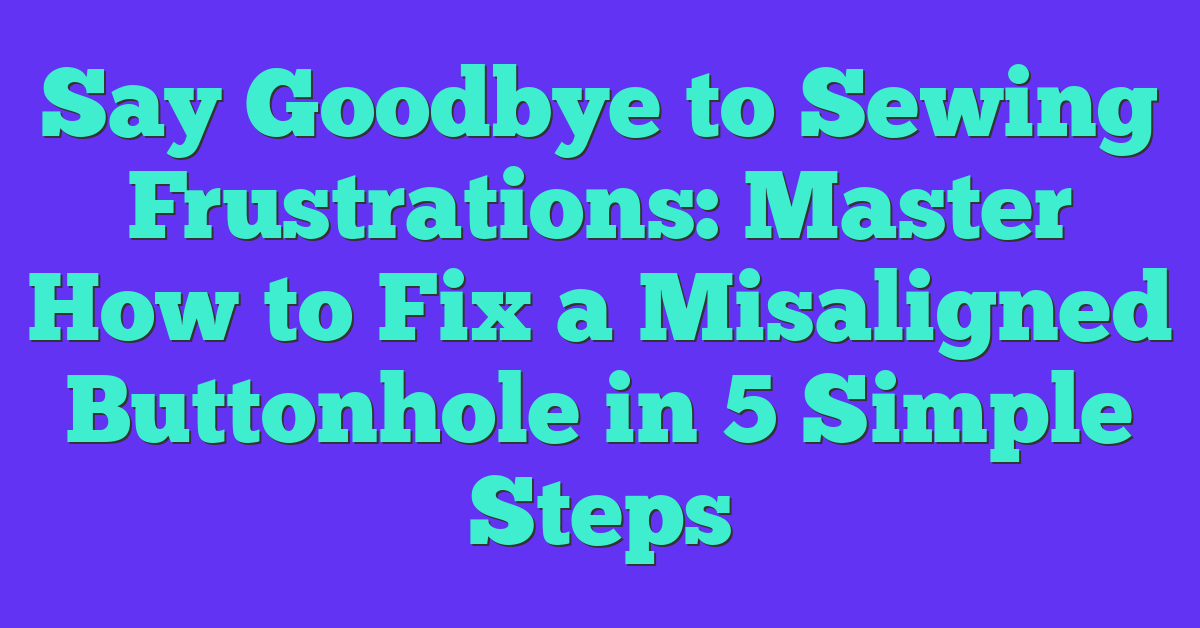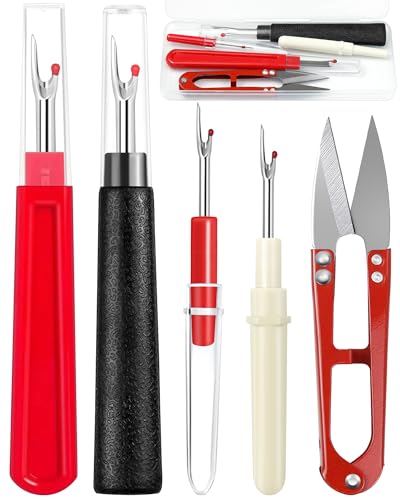We’ve all been there—excitedly sewing a new project only to find a buttonhole that’s completely off-kilter. It can feel like a small disaster, but don’t worry; fixing a misaligned buttonhole is easier than you might think. With just a few simple steps, you can turn that sewing mishap into a polished finish.
Understanding Misaligned Buttonholes
Misaligned buttonholes can disrupt the overall look of a garment, but identifying the problem can lead to a straightforward fix. Understanding the common causes and visual indicators helps address this issue effectively.
Common Causes
- Incorrect Measurements: I often miscalculate the spacing between buttonholes and buttons, leading to misalignment.
- Sewing Machine Settings: Using the wrong settings for buttonhole stitching can create uneven holes. It’s crucial to ensure the machine’s buttonhole foot is correctly adjusted.
- Fabric Type: Some fabrics can stretch or shift while sewing, causing the buttonhole to become misaligned. I usually recommend stabilizing slippery or stretchy fabrics.
- Improper Placement: Marking the buttonhole’s location incorrectly can result in misalignment. Double-checking markings before sewing can prevent this issue.
Visual Indicators
- Non-Symmetrical Appearance: A clear sign of a misaligned buttonhole is when the holes don’t line up straight or appear uneven in size.
- Difficulty in Button Insertion: If the button feels snug or gets stuck during insertion, it’s likely that the buttonhole is misaligned.
- Uneven Stitching: Close examination of the buttonhole’s stitch pattern can reveal inconsistencies. If stitches seem irregular, alignment needs attention.
- Gaps: Look for noticeable gaps between the buttonhole and its corresponding button. A significant gap indicates a need for adjustment.
Tools and Materials Needed
Fixing a misaligned buttonhole requires specific tools and materials. Having them on hand makes the process smoother.
Recommended Tools
- Seam ripper: This tool helps remove the incorrectly sewn buttonhole without damaging the fabric.
- Measuring tape: Accurate measurements ensure the new buttonhole aligns properly.
- Tailor’s chalk or fabric marker: These help mark the exact placement for the buttonhole on the fabric.
- Sewing machine: A reliable sewing machine with adjustable settings is necessary for creating a buttonhole.
- Buttonhole foot: This specialized foot helps guide the fabric accurately while sewing the buttonhole.
Essential Materials
- Thread: Use thread that matches the fabric to maintain a seamless look.
- Fusible interfacing: This stabilizes the fabric and prevents fraying, which is critical for buttonhole strength.
- Buttons: Make sure the buttons match the size and style you’ve chosen for your project.
- Fabric: Choose a fabric compatible with the buttonhole technique; thicker fabrics may require special settings.
- Scissors: Sharp fabric scissors are essential for cutting the buttonhole cleanly after sewing.
Step-by-Step Guide
This guide provides practical steps to fix a misaligned buttonhole effectively. Follow these detailed instructions to realign your buttonhole with precision.
Assessing the Misalignment
Identify the extent of the misalignment before starting any adjustments. Check these visual indicators:
- Non-Symmetrical Appearance: Look for uneven sizing on either side of the buttonhole. Measure both sides to determine how much discrepancy exists.
- Difficulty in Button Insertion: Attempt to insert the button. If it doesn’t fit easily, this suggests a misalignment.
- Uneven Stitching: Inspect the stitches around the buttonhole for consistent spacing. Variations may signal a flaw.
- Gaps Between Button and Buttonhole: Notice any noticeable spaces when the button is inserted. These indicate a sizing issue.
Gather this information to understand how to proceed with the necessary fixes.
Making Adjustments
After assessing the misalignment, start adjusting the buttonhole. Follow these steps:
- Remove the Misaligned Buttonhole: Use a seam ripper to carefully cut the existing buttonhole stitches. Take your time to avoid damaging the fabric.
- Mark the Correct Placement: Utilize tailor’s chalk or a fabric marker to outline where the new buttonhole should go. Ensure it’s centered and matches your button size.
- Reinforce the Fabric: To enhance stability, apply fusible interfacing around the new buttonhole area. This prevents fraying and helps keep the fabric in place.
- Sew the Buttonhole: With the adjusted markings in place, attach a buttonhole foot to your sewing machine. Use matching thread and follow your machine’s instructions to sew the new buttonhole.
- Trim and Clean Up: Carefully cut open the new buttonhole once sewn, ensuring clean edges. Use sharp fabric scissors for a neat finish.
Following these steps will help realign the buttonhole successfully, restoring functionality and aesthetics to your garment.
Preventative Measures
Preventing a misaligned buttonhole requires attention to detail and careful execution. By implementing proper techniques and maintaining your sewing tools, you can avoid common pitfalls.
Proper Sewing Techniques
- Measure twice: I always double-check measurements before cutting. Accurate placement ensures buttonholes align perfectly with buttons.
- Use a buttonhole foot: I advocate for using a buttonhole foot with my sewing machine. This foot helps create even stitches and maintains consistent size.
- Stabilize the fabric: I always add fusible interfacing to the fabric. This gives added support and prevents stretching, critical for buttonhole accuracy.
- Test on scrap fabric: I test buttonholes on a scrap piece of fabric before sewing on the final garment. This helps identify any issues with settings or placement.
- Sew with care: I take my time while sewing. Rushing increases the risk of mistakes, leading to misalignment.
Regular Maintenance
- Clean the sewing machine: I make it a habit to clean my machine regularly. Dust and lint can cause inconsistent stitching, leading to misaligned buttonholes.
- Check machine settings: I frequently verify machine settings are correct for the fabric I’m using. Proper tension and stitch length prevent complications during buttonhole creation.
- Replace dull needles: I don’t hesitate to replace my sewing machine needles. A dull needle can cause uneven stitches, affecting buttonhole quality.
- Lubricate moving parts: I ensure all moving parts are lubricated for smooth operation. This habit helps my sewing machine function optimally, reducing issues that lead to misalignment.
Conclusion
Fixing a misaligned buttonhole doesn’t have to be a daunting task. With a little patience and the right tools I can easily turn a sewing mistake into a polished finish. The key is to assess the misalignment carefully and follow the steps provided.
By understanding the common causes and taking preventative measures I can ensure my buttonholes are perfectly aligned in the future. Sewing should be a joyful experience and by mastering these techniques I can create garments that not only function well but also look great. Happy sewing!

















